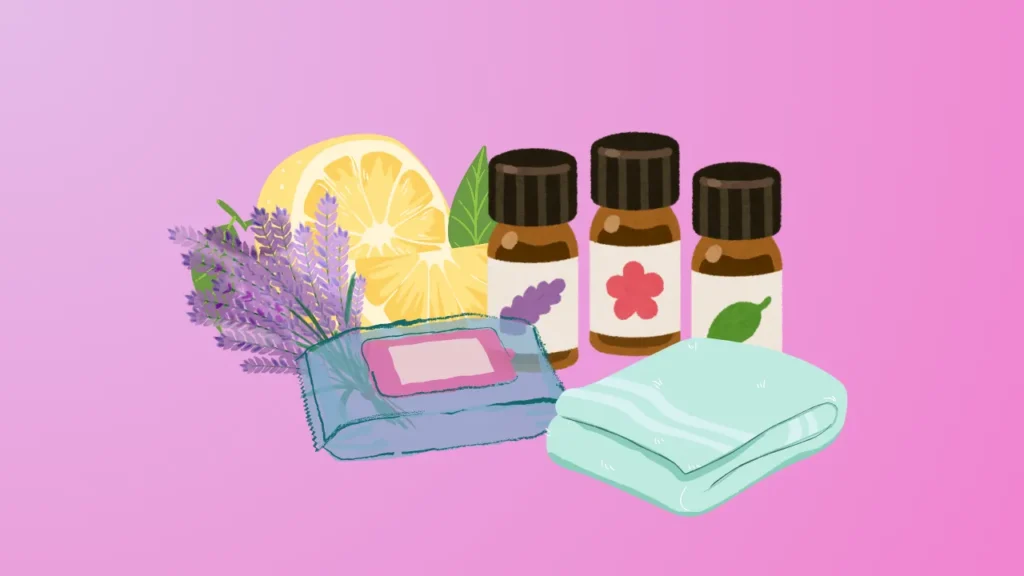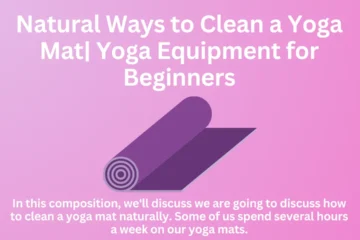Yoga beginner, are you looking for how to make an easy. nontoxic, aromatic DIY mat cleaner at home to clean mats? You don’t know how to clean a mat as a yoga beginner. In this blog, we will discuss how to clean a yoga mat at home. Some of us spend several hours a week on our yoga mats. Yoga has been a significant and integral part of my life for more than a year.
Considering how enthusiastic I am about yoga, I was surprised to see that I haven’t talked about it much on my site yet! I’ve talked publicly about my prior battles with anxiety and mental illness and how yoga played a key role in my healing. I make an effort to practice yoga regularly for my mental health; in fact, I’ve noticed that my anxiety gets worse if I skip too many sessions.
For the past few years, I’ve taken part in the Yoga Journey every January. I can’t suggest yoga enough, regardless of your level of expertise! I’ve loved every day so far, and it’s a great way to begin or resume a regular yoga practice. We practice yoga, and after class, our mats may become rather sweaty and filthy. I enjoy yoga for its numerous physical and emotional advantages.
You roll whatever mysterious goodies—or not-so-goodies—up with the mat when you roll it onto the floor and then back up again, onto the side where you place your hands, feet, and face. “A lab test conducted on several different yoga mats revealed that, among other things, some of the mats had millions of bacteria, fecal matter, allergens, yeast build-up (a type of fungus), and Staph,” the report adds. Awful, huh?
To stop bacteria from growing and preserve the integrity of our yoga mats for as long as possible, cleaning is crucial. However, the issue with the majority of yoga mat cleansers is that they can be costly, contain harsh or toxic ingredients (even “all-natural” sprays and wipes might include dubious emulsifiers, chelating agents, surfactants, and preservatives), and waste resources if they come in a non-reusable plastic container (among additional wasteful packaging).
I wanted to provide a simple DIY recipe with suggestions on creating your cleaner because I recently bought a new mat and it was vital to me to make a nontoxic cleaning. Instead of using those pricy, perhaps chemical-filled store-bought yoga mat cleaners, I suggest making your natural cleanser in 10 minutes using the simple DIY recipes below, all of which call for reusable materials.
How to Make Your Cleaning Spray for Regular Yoga Mats?
The formula I used is listed below, along with the justification for and advantages of the essential oils I utilized. It has a nice scent and cleans well.
Ingredients for the Yoga Mat Cleaning Spray
- One tablespoon (one part vinegar) of apple cider vinegar (ACV)
- One part water, three tablespoons of filtered water
- Six drops of Radiata (or eucalyptus) oil
- Five drops of Melaleuca tea tree oil
- Ten drops of lavender oil
- Frankincense Oil (10 drops) (or Frankincense Serrata)
Method of use
- Start by filling your 2-ounce glass spray bottle with one tablespoon of apple cider vinegar.
- Next, fill your 2-ounce spray bottle with about 3 tablespoons of filtered water, being sure to leave space at the top so that you may add essential oils without spilling.
- Fill your spray bottle with all of the essential oils (it doesn’t matter which sequence you use; just drip each one in).
- Shake thoroughly, close the bottle, and let the ingredients combine.
- You just need to add more essential oils by ¼ of the bottle filled with filtered water and ¼ of the bottle filled with ACV if you’re using a larger spray container. The highest dilution I advise for safety is somewhat less than 2%, which is what my recipe calls for.
Angie Jurgensen
The scent of the vinegar was so overpowering that I had to add more essential oils to the mixture—five drops at a 2% dilution. I could detect the aromatherapy of the EOs and the fragrance was much more pleasant than simply overbearing vinegar with this many oils. I chose Bragg’s Apple Cider Vinegar because it is raw, organic, and has several health advantages. It also requires less processing, which is healthier for the environment and you.
You can use it in dressings, drinks, and other recipes. It contains antibacterial and antifungal qualities and works as an emulsifier to break up any oils on the surface of your mat. This vinegar works wonders for organically cleaning and deodorizing your mat. Instead of using ACV, you might use a more processed white vinegar or alcohol-free witch hazel. I suggest Thayer’s witch hazel since it is created in the USA, isn’t distilled, isn’t paraben- or phthalate-free, and isn’t tested on animals.
Why Use Essentials Oils?
The essential oils in this mix not only give your cleaner a pleasant scent (vinegar on its own may be overpowering and unpleasant), but they also help eliminate odors and germs from your mat.
- Melaleuca, another name for tea tree oil, has antiviral, antibacterial, and antifungal properties. It’s possibly the most well-known antiseptic, and even though I don’t like the way it smells, this essential oil works wonders for organically cleansing your mat.
- In addition to its great odor-removing abilities, eucalyptus oil possesses antibacterial, antifungal, anti-microbial, and antiseptic qualities. Compared to Tea Tree, I like its “fresh, clean, and slightly woody aroma” more. Eucalyptus essential oil is said to have cleansing, energizing, calming, and cooling properties. It is not just a cleaning agent; it has many other applications and health advantages.
- One of the most well-known essential oils, lavender oil, is recognized for its energizing and relaxing properties. Both tea tree and eucalyptus combine nicely with lavender oil. But lavender also has antiviral and antibacterial properties. It is not only a wonderful fragrance for skincare, relaxation, stress alleviation, and mood enhancement, but it also has antimicrobial properties.
- The oil frankincense is regarded as “healing.” Given that it contains sedative qualities that reduce tension and anxiety, it is well renowned for being amazing for prayer and meditation, which makes it ideal for yoga. Although it also has antibacterial and disinfecting qualities to help cleaners, I included it for its aromatherapy benefits.

Not included here are the many applications and health advantages of these oils. Furthermore, this mixture strikes a good balance between fragrance and the three notes that categorize EO aromas:
- The most euphoric and lightest-smelling note in a combination, eucalyptus is also the most volatile (others include Grapefruit, Lemon, Peppermint, Mandarin, etc.)
- The middle note is the perfume’s primary component and the scent that lingers after the top note is: Tea tree with lavender (as well as geranium, rosemary, thyme, etc.)
- Base Note: Possibly the last note to be detected because of its heavier and richer nature, the base note is meant to remain the longest and contribute to the blend’s olfactory persistence. Frankincense (as well as rose, neroli, and sandalwood, among others)
Improve It
Naturally, you may change the essential oils in your homemade yoga mat cleaning spray to suit your preferences. For example, you may use simply eucalyptus or tea tree oil, or you can change the ratios of the oils I used. Other well-liked oils that may be used as cleansers include:
- Instead of tea tree or eucalyptus, which are both antimicrobial and invigorating, use lemon or peppermint.
- Instead of using lavender, another middle-note oil with antibacterial qualities, use geranium.
- Cinnamon contains antiviral and antiparasitic qualities, making it a fantastic warming oil for winter.
Many people like the grassy scent of thyme, which is an antiseptic and antibacterial top-middle note oil with relaxing qualities.
Recipe for a Homemade Cleaning Spray for Jade Yoga Mats (Natural Rubber Mats)
In my quest to find the ideal eco-mat for me, I recently bought a Jade Yoga Mat. I discovered that cleaning a natural rubber yoga mat is different from cleaning a regular yoga mat, which is why I love it and want to take good care of it. Sadly, there are no highly concentrated essential oils needed to properly clean a natural rubber yoga mat.
Jade suggests cleaning your mat with just vinegar and water (or a little soap if all the soap residue is gone). “It is crucial to remember never to use petroleum-based solvents, alcohol, or very concentrated essential oils on your mat. These cleaning products, regrettably, have a detrimental effect on the natural rubber in our mats, causing it to degrade and dry out.”
Rubber Yoga Mat Cleaning Spray Recipe (JADE) Natural
- A tablespoon of apple cider vinegar
- 3 tablespoons Water (preferably distilled or filtered)
- To make your cleanser more effective, you may add extra vinegar to the water, 50/50, so that it will naturally disinfect.
Method of Use
To fully combine, just pour the apple cider vinegar and filtered water into a 2-ounce glass spray bottle, seal it, and shake well. You may now use your cleaner by following the instructions provided below.
A tiny quantity of essential oils—like a drop of lavender, lemon, or eucalyptus—added to my jade mat cleanser now and then is OK, but use caution.

Apply the DIY Yoga Mat Cleaner
It’s fairly simple to use your cleaner on your mat after it’s prepared. Just adhere to these guidelines:
- Before using, give the cleaning spray container a good shake, and then freely spray the yoga mat cleanser over the whole surface (it’s safe to use).
- Allow the solution to sit on the mat for five minutes if you feel that it is particularly unclean and would want a deeper clean.
- Wipe your mat completely with a moist cloth to get rid of all the cleaning residue. (I usually soak my towel many times to get all of the cleaner off).
- Let your mat dry naturally.
- (This should only take five to ten minutes.) Alternatively, you can use a dry towel or washcloth to remove any leftover moisture. (Avoid letting your mat air dry in the sun, as this may cause many mats to deteriorate more quickly and lose their integrity, which can lead to warping or discoloration.)
- Continue on the opposite side.
It Smells Good!
- You may also sterilize and clean other fitness equipment with the essential oil spray.
- If your mat needs a thorough cleaning now and then, you can soak it in a bathtub for an hour with about a cup of vinegar, mild Dr. Bronner’s all-purpose soap, and essential oils (not in the bath for jade or rubber mats). Rinse, then hang it on the shower curtain rod to air dry, which could take up to 48 hours.
Conclusion
You may feel good about using all-natural chemicals to make your yoga mat cleanser at home in a reusable spray bottle. These simple, all-natural cleaning solutions are ideal for routinely cleaning your yoga mat: once every time you use it, or at least once a week, as is generally advised.
Make sure your homemade cleansers are as effective as the yoga mat cleaners in this post by following these steps:
- Antiviral and antibacterial
- Completely biodegradable
- No chemicals
- Without Bleach
- Free Phosphate
- Alcohol-free (won’t cause your mat to dry out)
- Free of Cruelty
- Environmentally friendly—you can reuse the same bottle and mix everything again!
I hope you enjoy your nontoxic homemade yoga wash and enjoy having a fresh and clean yoga mat that may also smell great for your practice. I hope you enjoy using your nontoxic DIY yoga wash and having a clean, fresh-smelling yoga mat for your practice. If you ever feel confused or need guidance, reach out to us through our contact form. I wish you a fulfilling and perfect yoga experience ahead!



0 Comments